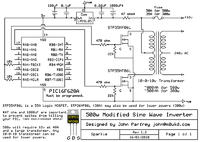mohajernow
Newbie level 3

Hi every one
In the last week I built a modified sine wave inverter using pic16f628a but there is a about 50-70 voltage drop when I put a 160 watt load
According to the data sheet of the power mosfet it can deliver about 110 A so
why the mosfets do not provide the desired current to the load ?
the following schematic is the basic of my design

and the proteus file (attached image) is my modified circuit

Any help or suggestion will be appreciated
In the last week I built a modified sine wave inverter using pic16f628a but there is a about 50-70 voltage drop when I put a 160 watt load
According to the data sheet of the power mosfet it can deliver about 110 A so
why the mosfets do not provide the desired current to the load ?
the following schematic is the basic of my design

and the proteus file (attached image) is my modified circuit

Any help or suggestion will be appreciated



